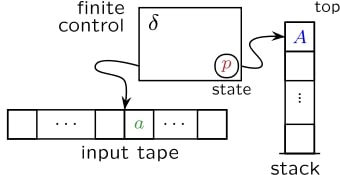

Pushdown Automata is a finite automata with extra memory called stack which helps Pushdown automata to recognize Context Free Languages.
A finite state machine just looks at the input signal and the current state: it has no stack to work with.
It chooses a new state, the result of following the transition.
A pushdown automaton (PDA) differs from a finite state machine in two ways:
1)It can use the top of the stack to decide which transition to take.
2)It can manipulate the stack as part of performing a transition.
A pushdown automaton reads a given input string from left to right.
In each step, it chooses a transition by indexing a table by input symbol, current state, and the symbol at the top of the stack.
A pushdown automaton can also manipulate the stack, as part of performing a transition.
The manipulation can be to push a particular symbol to the top of the stack, or to pop off the top of the stack.
The automaton can alternatively ignore the stack, and leave it as it is.

| Rules | Components |
| E → TX | q0 = { E } |
| X → ε | +TX | -TX | Q = { E, X, T, Y, F } |
| T → FY | Σ = { +, -, *, /, n, (, ) } |
| Y → ε | *FY | /FY | F = { F } |
| F → n | (E) |
Powered by w3.css
References Wikipedia
This page is made by Zeynep NASİP My Github Page